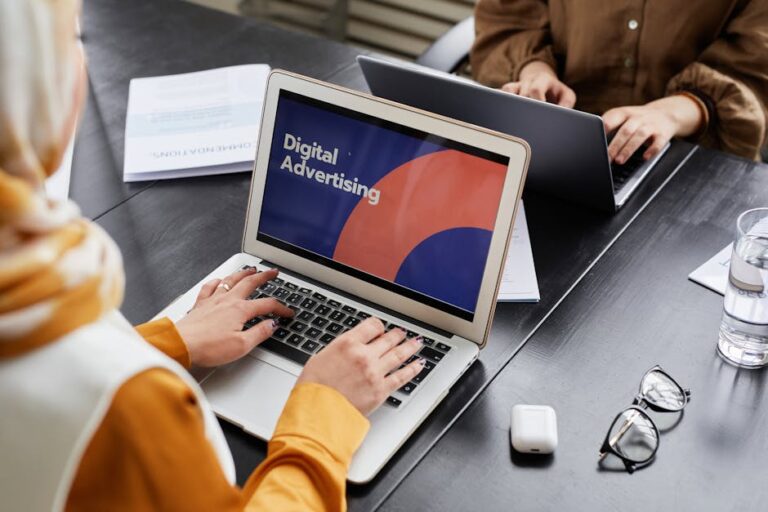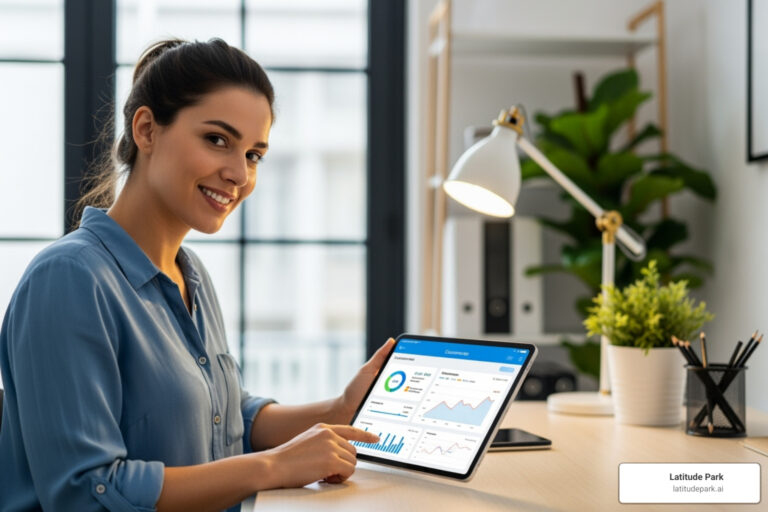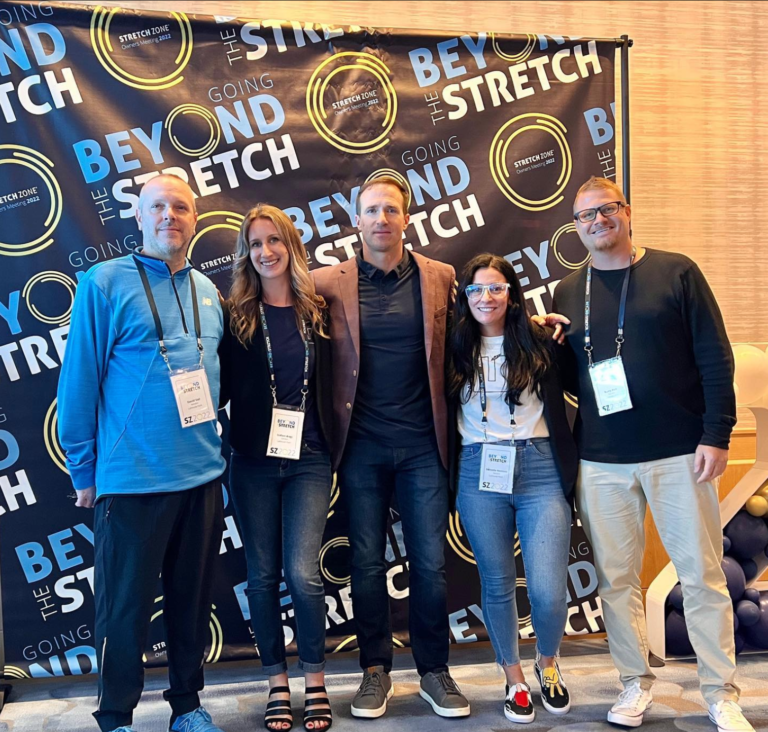Why Digital Advertising Matters for Modern Businesses
Digital advertising is the practice of promoting products or services through online channels like search engines, social media, websites, and mobile apps. Unlike traditional advertising, it allows businesses to target specific audiences, measure results in real-time, and adjust campaigns on the fly.
Quick Definition:
- What it is: Paid promotional content delivered through digital channels
- Where it appears: Search engines, social media, websites, apps, and streaming platforms
- How it works: Advertisers bid on ad space and target specific audiences based on demographics, interests, and behavior
- Why it matters: Reaches audiences where they spend their time, costs less than traditional media, and delivers measurable results
The numbers tell a compelling story. Digital ad spending surpassed $600 billion in 2023 and is projected to reach $870 billion by 2027. This growth reflects a fundamental shift in how people consume information and make purchasing decisions. Consumers spend more time online than ever, using various devices to research products, compare prices, and make purchases.
For businesses, this shift offers unprecedented precision in reaching the right customers. You can target people searching for specific products in specific cities and measure exactly how much revenue each dollar of ad spend generates. However, the digital landscape is also complex, with dozens of platforms and strategies.
The good news is that digital advertising is accessible to businesses of all sizes. You can start with a modest budget and scale up as you see results. The key is understanding the system, choosing the right channels, and optimizing based on performance data.
I’m Rusty Rich, founder and president of Latitude Park. With over 15 years of experience helping businesses steer Google, social media, and other platforms, I’ll break down the fundamentals of digital advertising in this guide to show you how to make it work for your business.
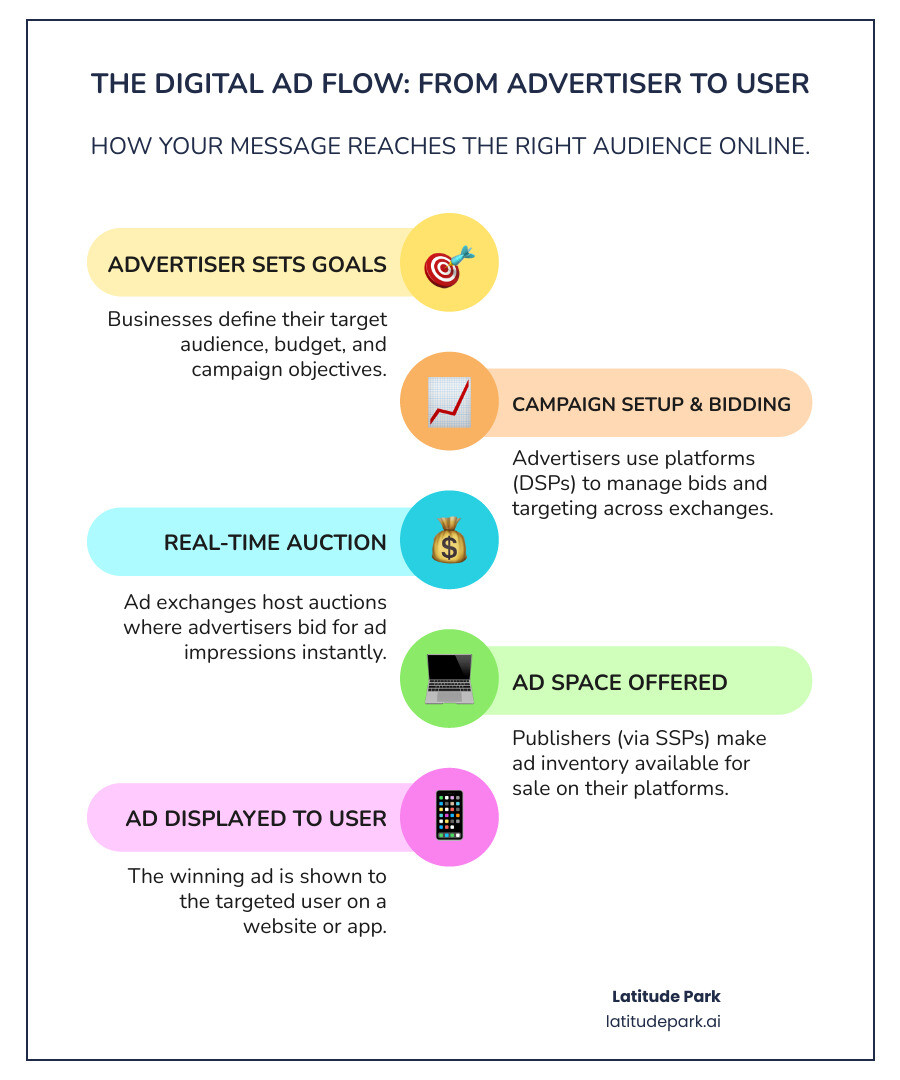
What is Digital Advertising and How Does It Compare to Traditional Methods?
Traditional advertising, like a billboard on a highway, shows the same message to everyone, whether they need the product or not. Digital advertising is different. It’s like having a conversation with someone who is already interested in what you’re offering, right when they’re most likely to buy.
Traditional methods—TV, radio, print—broadcast a single message to a wide audience, hoping the right people are paying attention. This mass marketing approach is inefficient. A local restaurant advertising on a city-wide radio station pays to reach thousands of listeners who live too far away to ever visit.
Digital advertising flips this model. Instead of shouting your message to everyone, you can speak directly to individuals actively looking for your services. When someone searches “best pizza near me,” your ad can appear instantly. This precision transforms advertising from a numbers game into a strategic conversation.

The differences extend beyond targeting. Traditional advertising is one-way communication with delayed feedback. Digital channels create two-way engagement, allowing you to track clicks, form fills, and purchases in real-time. This immediate feedback lets you adjust your strategy on the fly.
Cost structures are also worlds apart. Traditional media often requires large upfront investments. With digital advertising, you control your budget, starting small and scaling as you see results. You typically pay only when someone takes an action, like clicking your ad. This flexibility makes digital accessible to businesses of all sizes.
Key Differences at a Glance
| Feature | Traditional Advertising | Digital Advertising |
|---|---|---|
| Reach | Mass audience, broad geographic areas | Specific demographics, interests, behaviors |
| Targeting | Limited (e.g., magazine readership) | Highly precise (e.g., age, location, interests, online activity) |
| Cost | High upfront investment, less flexible | Scalable, flexible budgets, often lower entry cost |
| Measurement | Difficult (e.g., surveys, sales lift) | Real-time, detailed analytics (clicks, conversions) |
| Flexibility | Long lead times, hard to change after launch | Quick deployment, real-time optimization, A/B testing |
| Interaction | One-way communication | Two-way engagement, direct response |
| Content Format | Static images, audio, video | Text, images, video, audio, interactive elements |
The Shift in Consumer Behavior
This shift to digital matters because people have changed how they buy. Your customers are on their phones comparing prices, reading reviews, and searching for what they need. When people decide to buy something, 89% of them start with a search engine. They are actively looking for information and ready to engage.
Even more striking, when a search has clear buying intent, 65% of clicks go to paid ads. People click on ads because they provide an immediate answer to their needs. This behavior is dominated by smartphones, which have become central to daily life. Meeting your audience where they are—online—is the cornerstone of modern marketing. Digital advertising connects your offering with their need at the perfect moment. Learn more about this in our guide on Digital Ads vs. Attention Spans.
The Main Types of Digital Advertising Formats
Think of digital advertising as a toolbox where each tool serves a different purpose. Using the right format for each stage of the customer journey is what separates campaigns that drain budgets from those that drive real growth. Let’s walk through the main types.

Search Advertising
Search advertising, or Search Engine Marketing (SEM), meets raw buyer intent. When someone types “emergency plumber near me,” they’re ready to act. These text-based ads appear at the top of search results on platforms like Google. You bid on keywords your potential customers are searching for. It’s powerful because when people have commercial intent, 65% of clicks go to paid ads. Search ads can also increase brand awareness by 80%. For local businesses, showing up at this critical moment can make all the difference. We cover this in our Google Ads Local Business Guide.
Social Media Advertising
While search ads capture active hunters, social media advertising introduces your brand to people who didn’t know they needed you yet. Platforms like Facebook, Instagram, LinkedIn, and TikTok allow for remarkable targeting precision based on age, location, interests, and behaviors. The ads blend into feeds, making them less disruptive. The data shows it works: 78% of U.S. consumers have made purchases through findies on Facebook. Each platform serves a different purpose, from the broad consumer reach of Facebook and Instagram to the professional focus of LinkedIn and the creative frontier of TikTok. We offer guides on Facebook Ads for Small Business, Advertising on Instagram, Franchise Facebook Ads, and the Best TikTok Ad Strategy.
Display and Video Advertising
Display and video ads are the visual storytellers of digital advertising. They capture attention across millions of websites, apps, and streaming platforms.
Display advertising includes banner ads that are excellent for building brand awareness and keeping your business top-of-mind. They also fuel other channels; one study found 27% of consumers searched for a business after seeing its display ad. Their real power shines with retargeting—showing ads to people who have already visited your site. A website visitor who sees retargeting ads is 70% more likely to convert.
Video advertising takes engagement to another level, appearing on YouTube, social feeds, and websites. The format allows for storytelling that static images can’t match. The impact is clear: 88% of people have been convinced to buy a product after watching a brand’s video. And 70% of consumers have purchased from a brand after seeing it on YouTube. Explore video’s potential in our Google Discovery Ads YouTube Guide and through these video marketing effectiveness statistics.
The real power comes from using these formats together to guide customers from awareness to purchase.
How Digital Ads Work: From Targeting to Ad Serving
Understanding how digital advertising works behind the scenes is key. At its heart is programmatic advertising, an automated system that decides which ad you see in the milliseconds it takes a webpage to load.
When you visit a site with ad space, your browser signals an ad exchange—a digital marketplace. This triggers a real-time bidding (RTB) auction. Advertisers, using software called Demand-Side Platforms (DSPs), have already defined their target audience and budget. In an instant, multiple DSPs bid to show their ad to you. The highest bidder wins, and their ad is served to your screen. This entire process is what makes much of the internet’s free content economically sustainable.
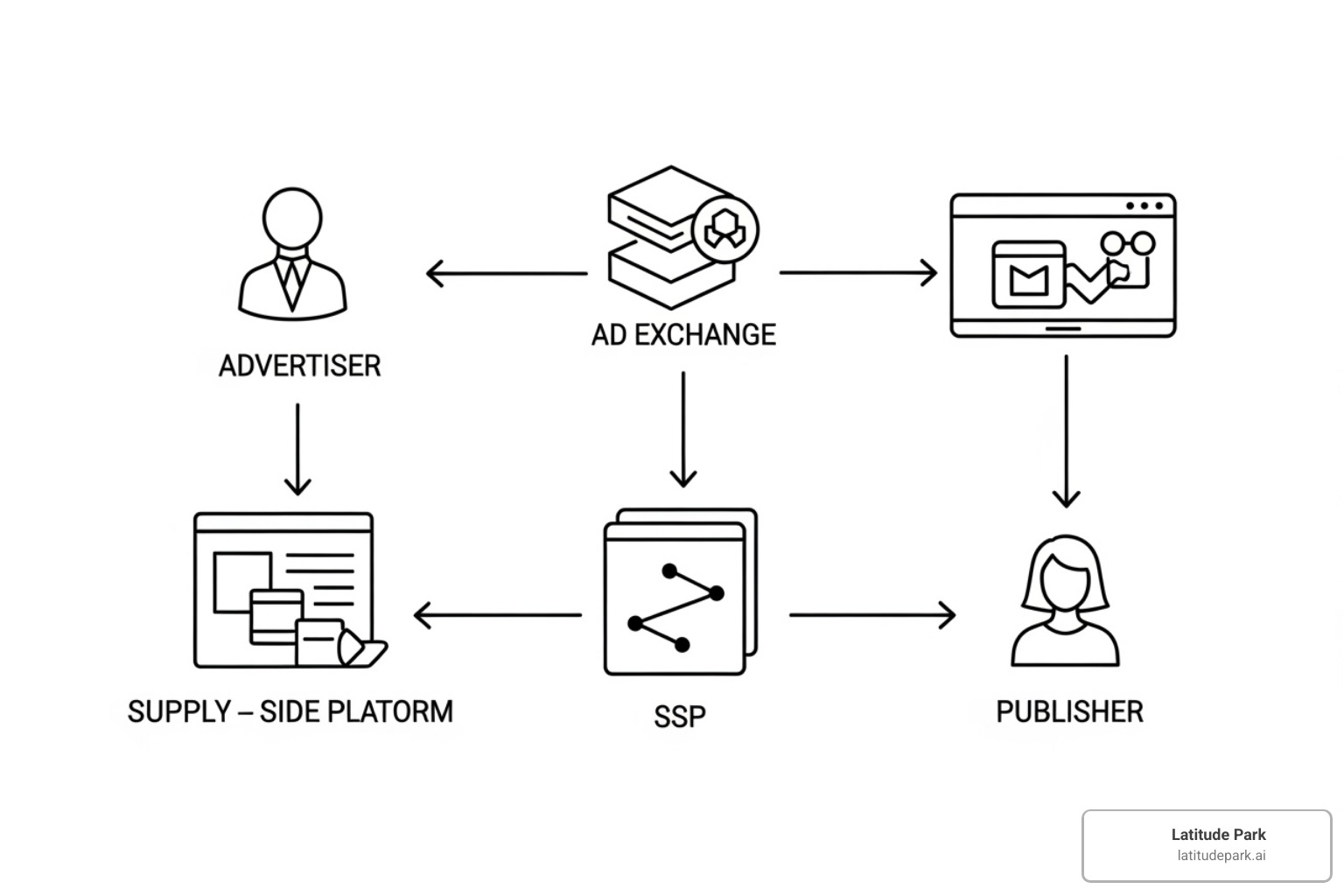
Small pieces of code called cookies and tracking pixels help measure performance and understand user behavior, allowing advertisers to continuously improve campaigns.
Common Targeting Methods
The real power of digital advertising lies in its targeting methods, which allow us to reach the right people at the right time.
- Demographic targeting: Reaching people based on age, gender, income, or education level.
- Contextual targeting: Placing ads on pages with relevant content (e.g., a kitchenware ad on a recipe blog).
- Behavioral targeting: Using past online behavior, like sites visited or searches made, to infer interests.
- Geotargeting: Targeting users by country, city, or even zip code. This is crucial for local businesses and franchises running campaigns like High Performance Meta Ads.
- Retargeting (or remarketing): Showing ads to people who have already interacted with your brand, such as visiting your website. This is highly effective for bringing back interested customers.
Combining these methods allows for incredibly precise and effective campaigns, like using geotargeting for Best Google Ad Extensions for Local Business Clients.
Understanding Interest-Based Digital Advertising and User Privacy
Interest-based advertising is why ads can feel so relevant. It uses information about your online activities—like browsing history and search queries—to group you into audiences with similar predicted interests. The goal is to show you ads you’re more likely to care about.
This process is designed to be transparent. You may have seen the small blue AdChoices icon on some ads. Clicking it provides information about why you’re seeing the ad and gives you control over your preferences. Industry guidelines, like the Digital Advertising Alliance (DAA) principles, help ensure these practices are responsible.
User Controls and Opt-Outs
You have control over your data and ad experience. Digital advertising funds many free services, but you can manage your privacy.
- Privacy Settings: Major platforms and browsers let you control data collection and disable personalized ads.
- Cookie Management: Your browser allows you to block or clear cookies used for tracking. Be aware that this may affect some website functionality.
- Ad Blockers: These tools prevent ads from appearing but also impact the revenue that supports free content creators.
- Opt-Out Tools: Centralized tools from the DAA and the Network Advertising Initiative (NAI) let you opt out of interest-based advertising from many companies at once.
These tools empower you to customize your online ad experience to your comfort level.
Measuring Success and Best Practices for Digital Advertising
Running a digital advertising campaign is only half the battle; the real magic is in the data. Unlike traditional advertising, we can track nearly every interaction, understand what’s working, and optimize in real time. Success is built on a solid foundation of clear goals and continuous improvement.
Key Metrics for Measuring Digital Advertising Success
In digital advertising, we live by data. Here are the key performance indicators (KPIs) we watch closely:
- Impressions: How many times your ad was displayed. This measures reach.
- Click-Through Rate (CTR): The percentage of people who saw your ad and clicked it. A high CTR indicates relevance.
- Cost Per Click (CPC): What you pay for each click. Lowering CPC stretches your budget.
- Conversion Rate: The percentage of users who completed a desired action (e.g., a purchase or form fill) after clicking.
- Cost Per Acquisition (CPA): The total cost to acquire one new customer or lead.
- Return on Ad Spend (ROAS): The revenue generated for every dollar spent on advertising. This is the ultimate measure of profitability. For example, Google Ads reports an average ROI of 800% ($8 in revenue for every $1 spent).
Monitoring these metrics helps spot issues like a Google Ads Performance Dropping and understand trends like Why Meta Advertising Costs Are Increasing in 2025.
Best Practices for Effective Campaigns
Success in digital advertising comes down to following a few fundamental principles:
- Know your audience: Deeply understanding your target customer’s demographics, interests, and pain points is the foundation of any great campaign. 71% of consumers prefer ads targeted to their interests.
- Set a realistic budget: Start with a budget that aligns with your goals and allows enough time for data collection, then scale what works.
- Continuously monitor and optimize: Digital campaigns are not “set it and forget it.” Regular review, A/B testing, and refinement are essential for improvement.
- Ensure mobile-friendliness: With most traffic coming from mobile, your ads and landing pages must provide a seamless experience on all devices.
- Align ads with the sales funnel: Use different ad types for different stages of the customer journey—awareness, consideration, and conversion. Match your message to where the customer is in their decision-making process.
Frequently Asked Questions about Digital Advertising
How much does digital advertising cost?
The cost of digital advertising is flexible, which is good news for businesses of all sizes. Unlike traditional media’s large upfront commitments, digital platforms let you start with a budget you’re comfortable with—even as low as $10 a day—and scale up as you see results.
Most platforms use an auction system where you pay per click (CPC) or per thousand impressions (CPM). You set daily or lifetime budgets, giving you complete control over your spending. Costs are influenced by factors like industry competition, audience targeting, and ad quality, but the key takeaway is that you can find an approach that fits your budget and delivers a measurable return.
How long does it take to see results from digital ads?
It depends on your goals. You can see immediate results like website traffic within hours of launching a campaign. However, most ad platforms have a learning phase that lasts from a few days to a couple of weeks. During this time, the system’s algorithm gathers data to optimize ad delivery, so performance may be inconsistent. It’s best to avoid major changes during this period.
For long-term goals like brand building, results are more gradual. If you’re running lead generation campaigns with a long sales cycle, it may take weeks or months to see final conversions. As a rule of thumb, plan to run a campaign for at least three to four weeks to gather enough meaningful data to make strategic decisions.
Is digital advertising effective for small businesses?
Absolutely. In many ways, digital advertising is better suited for small businesses than large corporations. Here’s why:
- Accessibility: The low barrier to entry means you don’t need a massive budget to compete. A local business can run effective ads for less than the cost of a single newspaper placement.
- Precision Targeting: Small businesses often know their customers intimately. Digital platforms let you target those exact people based on location, demographics, and interests. This precision, especially for local advertising, prevents wasted ad spend. We use these principles in our Digital Advertising for Multi-Location Businesses approach.
- Measurable ROI: You can track exactly what your advertising dollars are achieving—clicks, calls, and sales. This transparency is invaluable for small businesses on a tight budget, as it allows you to invest in what works.
The key to success isn’t the size of your budget; it’s having a smart strategy.
Conclusion: Embracing Digital Advertising for Growth
If there’s one takeaway, it’s this: digital advertising is the foundation of how modern businesses connect with customers. The shift from mass media to precision-targeted online campaigns has fundamentally changed what’s possible for businesses of every size.
We’ve seen how search ads capture intent, social media builds connections, and video tells compelling stories. The numbers back it up—with an 800% average ROI on Google Ads and 89% of buying journeys starting with a search, the opportunity is undeniable. Digital advertising is what keeps much of the internet free and provides an unparalleled chance to reach the right people at the right time.
The landscape is always evolving with AI and privacy changes, but these are opportunities to build smarter, more respectful campaigns. For multi-location businesses and franchises, navigating this complexity requires specialized expertise to ensure brand consistency and local optimization.
At Latitude Park, this is what we do. We specialize in helping franchises grow through effective Meta advertising and comprehensive digital advertising solutions custom for multi-location businesses. Our approach addresses coordination challenges to drive growth across all your locations.
Whether you’re just starting or refining a long-term strategy, the principles are the same: know your audience, set clear goals, measure everything, and never stop optimizing. Your customers are online right now. The question isn’t whether to accept digital advertising—it’s how quickly you can harness its power for your business.
Ready to take your digital advertising to the next level? Explore our Google Ads solutions to learn how we can help your business thrive: Google Ads Solutions




